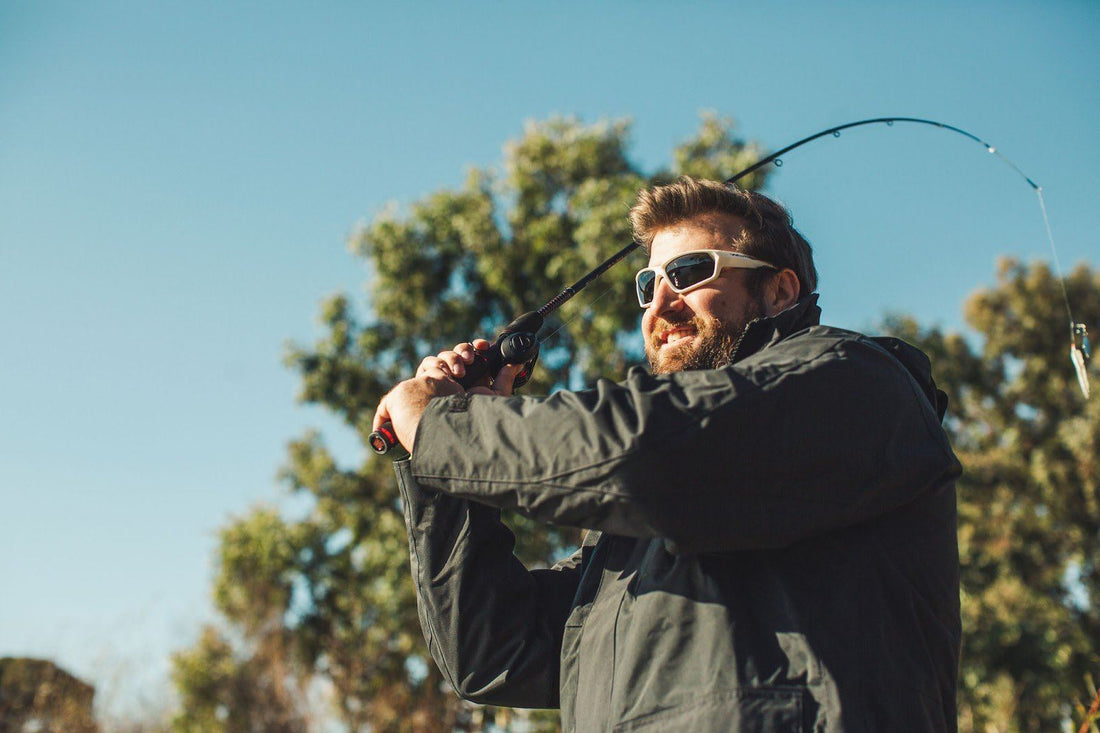
What is the Best Jacket for Fishing?
When it comes to choosing fishing outerwear, there are a number of factors to consider. These are basically two-fold; how well it protects you from the elements, and how well it provides comfort and freedom of movement. These two categories will often determine the difference between a good day and a bad day on the water.
1). THE ELEMENTS
Waterproofing - the dry factor is paramount when it comes to fishing outerwear. Fishing can often be best when the weather is volatile, and that means sudden cloudbursts with pounding rain and wind gusts. To combat this, today’s high tech fabrics utilize DWR coating - which is a durable water-repellent finish.

You can test this DWR performance by simply sprinkling water over the garment. If it beads up and rolls off easily, then typically so will the rain. If it is absorbed and darkens the fabric the DWR is either insufficient or no longer performing. It is critical to establish this for any new garments, and be aware that this coating will diminish over time. When this occurs, you’ll need to address it with the proper washing instructions that will clean and restore the DWR properties.
Durability - the construction of the outerwear will determine how well it can withstand not only the elements, but the scrapes, scratches and gouges that come from a typical day of fishing. You will have hooks snag it and sharp edges grab it as you go through an average day on the water, and fish blood and slime coat it on a great day on the water. How well it is designed to perform in these conditions will determine its durability over time.
Seams are the weak point of any waterproof jacket, and the best will be welded seams that ensure no water gets through them. They are also reinforced to prevent separation under excessive force or repetitive motion, both of which are common in fishing conditions.
Accessibility - zippers, pockets and hoods are an essential part of any rain jacket, and these are of great importance to anglers. They need to be easily used and extremely durable.

Zippers should be wide and have sturdy tabs. A failed zipper often renders a garment unusable long before it actually wears out. It is also helpful to have main zippers protected by outer storm flaps to further protect from the elements and preserve the life of the zipper.
Pockets are of utmost importance to most anglers, and accessing them with ease is a crucial test when selecting your jacket. Fly fishermen may want several smaller pockets, while others may like the convenience of having everything within easy reach. This comes down to your own preference, but having them secure will be critical to everyone. Inside pockets designed for things like keys and phones must offer easy access yet full protection from anything being lost.
Hoods are a no-brainer when it comes to rainwear, but not all hoods are created equally. They will all tend to be lightweight and feature a tightening function, but a major difference comes when you are NOT using the hood. Designers typically have two ways of addressing this - either a detachable hood or a roll away design. The detachable option means you’ll need to store it somewhere when detached, whereas the roll away tucks into the collar. Both have advantages and disadvantages, and will largely come down to your preference.

Hoods that are designed for foul weather will typically have a bill to divert heavy rain from your face and optimize visibility. They will also often be lined to offer additional insulation from the cold that often accompanies heavy rain, especially in the colder months.
2). COMFORT
The second consideration when choosing a fishing jacket is obviously comfort and ease of movement. In order to enjoy your time on the water, you need to remain warm and dry, release your body heat, and have the ability to move your arms and torso easily while casting.
Breathability - this refers to how well your jacket allows your body heat to escape during extensive activity. A lack of this will cause you to feel wet and clammy over time. A good jacket will always offer a waterproof/breathable membrane that keeps precipitation off you, and wicks perspiration away from you. This is key to all fishing apparel.
Sleeves - these are crucial to anglers as the last thing you want is water trickling down your arms, and you may find yourself with your arms extended or over your head for long periods. Adjustable cuffs are the primary method for achieving this, which will usually utilize velcro or straps. They may also include an inner cuff to further protect from this, and insulate from the cold. Choosing a jacket that simply has open sleeves is a choice you may soon regret.
Lining - all fishing jackets will typically feature some type of inner lining. The weight of this will largely depend on the climate in which you’re fishing. Lighter jackets will most likely use a polyester mesh that offers easy breathability without adding much weight, whereas heavier foul weather jackets will usually have fleece for added insulation and comfort.
In either case, a good fishing jacket will not restrict the movement of your arms or torso. They will keep you dry inside and out, and offer packability that enables you to easily store them with your fishing gear. They shouldn’t require much space, yet provide the peace of mind of knowing you’re prepared for whatever Mother Nature has in store for you out on the water.

So how do you know if you need a rain jacket vs. a foul weather jacket? Here is a link to show you the differences between the two for making that decision: https://youtu.be/3bsoUJr7D-s
In the end, you may need both to ensure you make memories instead of misery. Fish on! -WR
